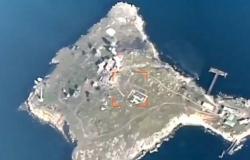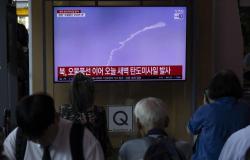Milky Way. On the left, the halo appears messy and “wrinkled”, a sign that the merger occurred relatively recently. On the right, it appears smooth and uniform, a sign that the fusion occurred in the ancient past. Credits: Halo stars: Esa/Gaia/Dpac, T Donlon et al. 2024; Background Milky Way and Magellanic Clouds: Stefan Payne-Wardenaar.
The curious case of our galaxy which, as it ages, loses its “wrinkles”. No, we’re not talking about a new film with Brad Pitt, but about new clues to understanding the universe. Researchers at Rensselaer Polytechnic Institute in the United States may have overturned theories about the formation of the Milky Way by suggesting that our galaxy’s last major collision occurred billions of years later than previously thought. The discovery was made possible thanks to the analysis of data present in the third catalog (Data Release 3) of Gaia, the European Space Agency satellite which is mapping more than a billion stars throughout the Milky Way, following their movement, brightness, temperature and chemical composition.
In this case, Heidi Jo Newbergan astrophysicist at Rensselaer Polytechnic Institute, known for her work in understanding the structure of our galaxy, and Tom Donlon, a researcher at the University of Alabama, focused on the so-called “wrinkles” that form when the Milky Way collides with other galaxies. «As we age, wrinkles increase, but our work reveals that the opposite is true for the Milky Way. It’s a sort of cosmic Benjamin Button, which becomes less wrinkled as time passes,” says Donlon, first author of the new study, published last month in Monthly Notices of the Royal Astronomical Society. “By looking at the way these wrinkles dissipate over time, we can trace back to when the Milky Way underwent its last major collision, discovering that this occurred billions of years later than we thought.”
Like those on our bodies, therefore, even the “galactic wrinkles” would be the sign of time passing – albeit on the contrary, “smoothing out” over the years – and would show the traces left by the various galactic clashes. The internal halo of the Milky Way contains, in fact, among its “folds”, stars with a component rich in iron (therefore with high metallicity) and with very eccentric orbits, and is often indicated as a sign of the last great galactic merger . Although hypotheses on the origin of the stellar halo are different, the morphology of the stellar debris and the metallicity of the stars within it – two aspects that depend on the time they have had to mix in phase – can provide valuable indications on the age of the galaxy .
By comparing the observations of the wrinkles with the cosmological simulations, the team was therefore able to state that the last significant collision of the Milky Way with another galaxy did not occur around ten billion years ago, as previously thought, but at least five billion years later. Until now, it was thought that our galaxy had incorporated a similar one – Gaia-Enceladus, with dimensions slightly larger than those of the Small Magellanic Cloud, a satellite galaxy of the current Milky Way – whose surviving stars would have formed a substantial part of the internal halo of our galaxy and going to “inflate” the internal galactic disk. Scientists had dated this collision – which would have generated a large number of stars with unusual orbits – between 8 and 11 billion years ago, calling it the Gaia-Sausage-Enceladus (GSE) merger.
Now, Newberg and Donlon’s results would prove that the time of the Milky Way’s last significant collision with another galaxy was at least five billion years later, and that stars with unusual orbits could result from the so-called Virgo Radial Merger, a “lateral collision” with a galaxy from the Virgo cluster occurred less than three billion years ago.
«Every time the stars swing back and forth across the center of the Milky Way, new “wrinkles” form. For the wrinkles of stars to be as obvious as they appear in the Gaia data, they must have joined us no less than three billion years ago – at least five billion years later than previously thought,” Newberg explains. “If they had joined us eight billion years ago, there would be so many wrinkles next to each other that we would no longer see them as separate elements.”
In practice, if the Milky Way’s shocks were older, the wrinkles would be less distinct from each other and its “galactic face” would appear smoother and more uniform. Just like what happens to the protagonist of the story written by Francis Scott Fitzgerald in 1922.
To know more:
Watch the animation of a galactic collision:






